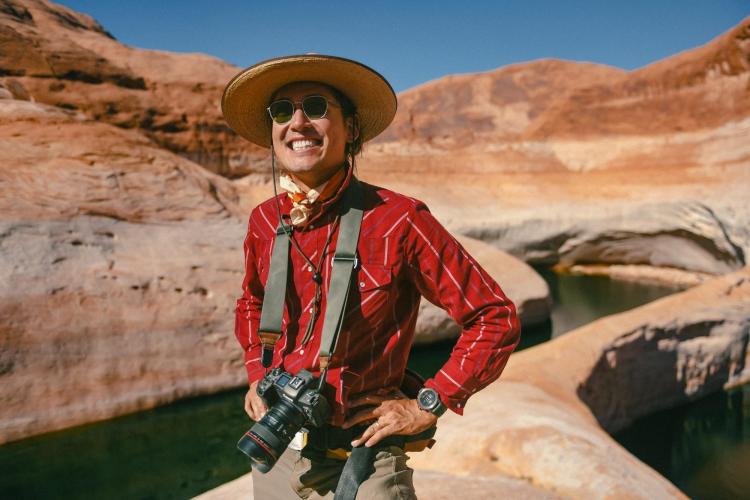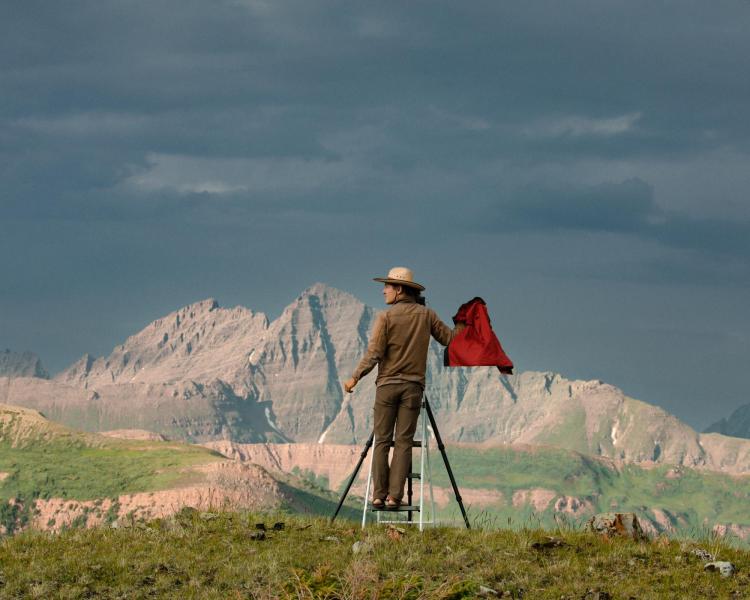The Ted Scripps Fellowships have been bringing award-winning environmental journalists to CU Boulder for 27 years. Fellows embark on a year of courses, projects, field trips, seminars and more— taking advantage of everything university life has to offer. This series is a chance to get to know this year’s cohort of talented journalists beyond what a typical bio page will tell you.
Elliot Ross is an American photojournalist who tells stories of the American West through long-term projects that follow the individual threads that make up the tapestry of our communities, landscapes, and cultures. During his fellowship, Ross plans to investigate the water crisis unfolding across the Western United States. Ross’s work can be seen in National Geographic, The New York Times, and The New Yorker.
Ross sat down with CEJ graduate assistant Devin Farmiloe to talk about his work and experience as a fellow.
 Your photo journalism has focused primarily on the cultural geography of the American West. Could you tell me a bit about how you see the climate crisis impacting this landscape?
Your photo journalism has focused primarily on the cultural geography of the American West. Could you tell me a bit about how you see the climate crisis impacting this landscape?
It's impacting every level of society. I think there are two important considerations that have driven my practice and I feel I have a responsibility to contribute. I see climate change impacting Western America through equity issues: Who has the ability to thrive, and who is being more disenfranchised than ever? I see that the gap is widening between those who have and those who don't. And the other way, which is related and they inform one another, is access to resources and specifically how climate change impacts hydrology and where water goes and where it does not go, and who within our legal and societal framework has access to that water. I’m interested in reexamining institutions that have led to the paradigm in which we exist today. I think climate change doesn't necessarily change social order, but rather it exacerbates and heightens the divisions and issues that we have already.
What is a photo story that has informed your reporting on this topic?
One project that has had an outsized influence on my relationship to photography is an ongoing project in the Inupiat village of Shishmaref located in Northwest Alaska, above the Bering Strait. This indigenous community is facing an existential threat as the waters of one of the world’s most violent stretches of ocean rise around their quarter-mile-wide barrier island. In the 1930’s, indigenous across the American West, Canada and Alaska were forcibly settled through a brutal campaign of cultural genocide by their respective governments. Prior to that, this area was Inupiat hunting ground for millennia, but due to its exposure, never a place to live year-round. With warming, rising oceans and a lack of protection by pack ice that no longer forms in time for October’s storm season, this island with a high point of just 14 feet above sea level, places Shishmaref in a very precarious position. All it would take is one significant storm event to completely inundate this community that has no means of escape.
For the last four years, I've been traveling back and forth, living with one family. Over time, I’ve witnessed the physical disintegration of the community–buildings, homes and roads succumbing to the ocean. I’ve also seen the strength and character of community leaders, and the incredible resilience born from their culture and the tightness of village life. When thinking about my practice, this experience has given me so much humility. Humility born from the experience of living in someone's home, and the generosity my hosts extend to me despite the small mistakes I make and the imposition of my presence. My hope is that my photography exudes the grace, dignity and humanity that has been given to me by the people of Shishmaref. I’ve learned that it’s through these human qualities that I have the best chance of connecting with a broader, global audience on this difficult and remote issue. Shishmaref has allowed me to grow in a safe space both as a journalist and a human.
Speaking of a safe space to learn, how have you been enjoying your time in the fellowship so far?
It's been such a gift. While at times I do feel adrift in the hormonal sea that is campus life, mostly I'm feeling invigorated by the amount of energy here; a frequency of energy that only comes from an inspired learning environment. It's really incredible sinking into this place as I never had a true collegiate experience at art school. The amount of support that we have through CEJ and CU faculty has been so helpful and inspiring. Sharing this time with my four fellow fellows, all going through these new experiences together, has been such a joy. You should see our WhatsApp thread… it bubbles with the enthusiasm of a new crush.

What is your favorite class so far?
My favorite class, hands down, is called Colorado River Water Crisis, which is right up my alley. The educator, Martin Hoerling, recently retired from an illustrious career at NOAA brings that deep experience into the classroom. Hoerling is able to convey difficult concepts and articulate nuance within contentious issues through his deep well of knowledge. But also, again, it comes down to my peers. Within this small class, there are a handful of subject experts from institutions like the Bureau of Reclamation, Denver Water as well as other professors. So the conversation that happens on an organic level is really interesting too.
What do you do outside of journalism?
As cliche as it sounds, I love to explore. I love diving into my physical surroundings. Every evening here in Boulder, you’ll find me walking around eyes wide, following my curiosity and engaging with random people. Just last night, I shared supper with a man who sat across from me at the Bavarian beer hall, as I was eating my schnitzel. He was also alone, here for work, as he built a quantum computing lab for Google. We had a really interesting conversation surrounding AI and the ceiling of the technology that he believes we’ve already hit. The same curiosity goes for when I'm in the wilderness. I love spending time in my beloved canyon country of the Southwest. Each mile spent walking through these landscapes is like reading the most illuminating chapter you've ever read. There's so much to learn, from the ecology, to the geomorphology, to the atmosphere overhead, and the artifacts underfoot that reveal a deep lineage of humanity.
